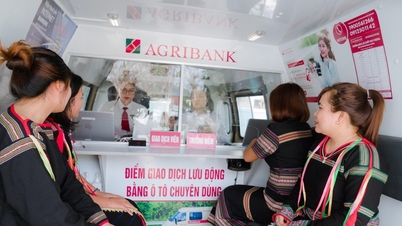Many banks are continuously offering loan packages that support early repayment of loans at other banks with competitive interest rates, along with a commitment to automatically pay off the outstanding balance for customers. The applicable interest rate ranges from 5% to 8% per year, depending on the loan term and the approval conditions of each customer.
Unexpectedly, lending interest rates are even lower than deposit interest rates.
More than a year ago, Circular 06 of the State Bank of Vietnam officially came into effect, supplementing regulations allowing credit institutions to consider and decide on loans for customers to pay off debts at other credit institutions for the purpose of serving living needs.
In the "race" to lend money to customers to pay off their debts early at other banks, large-scale banks with reputable brands, low input capital costs, and efficient appraisal and disbursement processes will have a significant advantage.
Typically, Agribank has just launched an attractive loan interest rate, even considered "unbelievably low". The bank's short-term loan interest rate is currently on par with the interest rate on savings deposits with terms of 3-11 months at Agribank, ranging from 2.5% to 3.5% per year.
Specifically, from now until December 31, 2025, businesses borrowing from Agribank to repay debts early at other credit institutions will enjoy preferential interest rates: Short-term loan interest rates starting from only 2.4%/year. Medium and long-term loan interest rates starting from 6.0%/year, with a fixed interest rate period of up to 24 months.
The maximum loan limit is equivalent to the outstanding principal balance at other credit institutions. For medium- and long-term loans that have not been fully disbursed, Agribank will continue to disburse the remaining amount according to the limit previously granted to the customer by the credit institution. In addition, short-term borrowers may also benefit from preferential policies regarding collateral as stipulated by the bank from time to time.
According to our research, Agribank's short-term loan interest rates are currently lower than the 6-month deposit interest rates of most other commercial banks. Meanwhile, medium and long-term loan interest rates are also on par with the deposit interest rates of many other banks.
Currently, many banks are offering loan packages to help customers settle their debts early at other banks, with interest rates ranging from 5% to 8% per year, depending on the loan term and individual customer conditions.
In fact, after the new Circular came into effect, banks continuously launched preferential loan packages to attract customers. However, although the interest rates for early repayment loans seem attractive, the procedures are a major obstacle. Many banks require customers to settle their old loans themselves, transfer collateral to new collateral, and go through the full appraisal and loan application process at the new bank.
Furthermore, customers also have to pay early repayment penalties, typically ranging from 0.5% to 2%, and potentially higher depending on the regulations of each bank. In addition, a host of other costs arise, including: land title release fees, new mortgage registration fees, notarization fees, new loan insurance fees, etc.
Transferring collateral from the old bank to the new bank also consumes considerable time and cost. To be approved for a loan, customers need to have a good repayment history according to data from CIC and demonstrate a stable income to ensure their ability to repay the loan.

Competition is becoming increasingly fierce.
Currently, many commercial banks are actively implementing preferential credit packages to boost credit growth starting from the beginning of 2025. The State Bank of Vietnam aims for a system-wide credit growth rate of 16%, higher than in previous years, in the context of the Government's expectation of GDP growth of around 8%.
To boost loan disbursement, while good customer groups are becoming increasingly scarce due to the economic situation, banks are actively implementing programs to allow early repayment of loans at other banks with more flexible and open conditions.
According to experts, with preferential policies and flexible support procedures, banks are striving to attract customers to achieve credit growth targets. Dr. Le Xuan Nghia commented that real estate remains an important disbursement channel, especially the housing segment serving real needs.
Previously, homebuyers had to pay high interest rates on loans. Now, with policies allowing early repayment of loans from other banks and competitive interest rates, the race to attract customers among banks is becoming increasingly fierce.
Many customers, after the preferential interest rate period at their old bank ends, are now subject to floating interest rates of up to 11-12% per year. Meanwhile, the preferential interest rate during the initial period when switching to a new bank was only 5-7% per year.
This difference is significantly higher than the early repayment penalty fee, leading many customers to willingly accept the penalty fee in order to benefit from the new loan policy.
Source: https://baodaknong.vn/ngan-hang-chay-dua-thu-hut-khach-vay-de-tat-toan-no-tai-to-chuc-khac-243288.html




![[Image] Close-up of the newly discovered "sacred road" at My Son Sanctuary](/_next/image?url=https%3A%2F%2Fvphoto.vietnam.vn%2Fthumb%2F1200x675%2Fvietnam%2Fresource%2FIMAGE%2F2025%2F12%2F13%2F1765587881240_ndo_br_ms5-jpg.webp&w=3840&q=75)


































































































Comment (0)